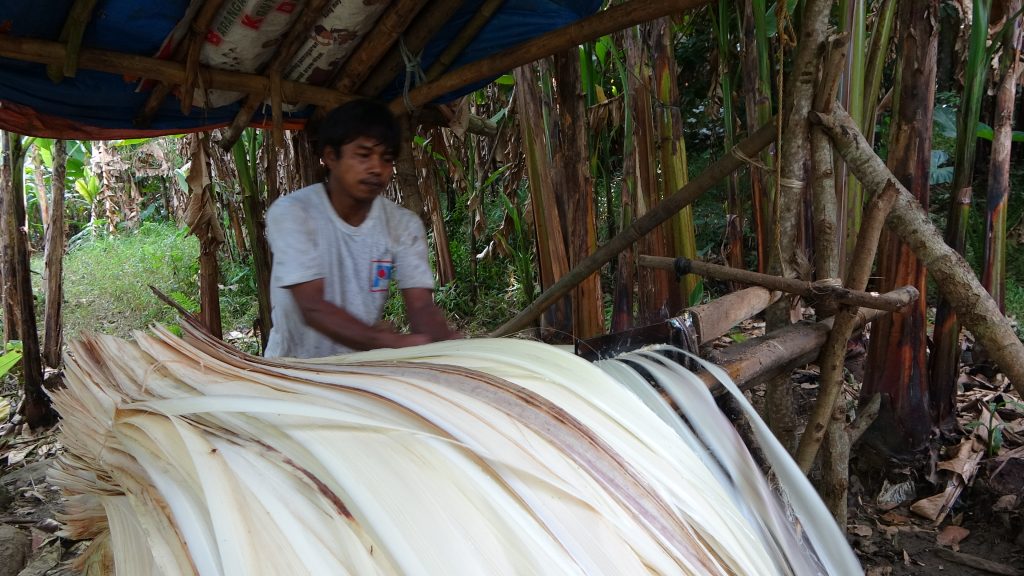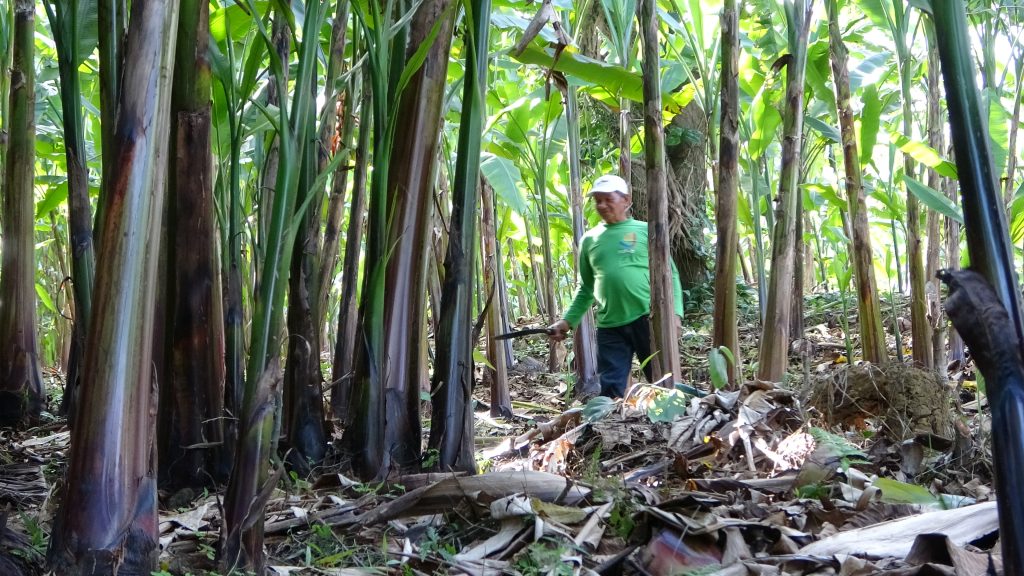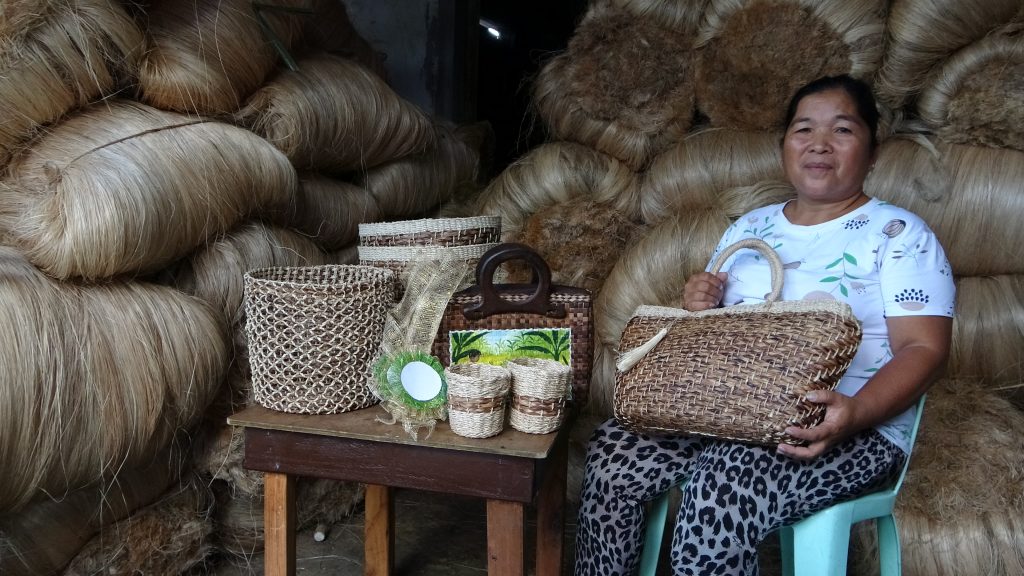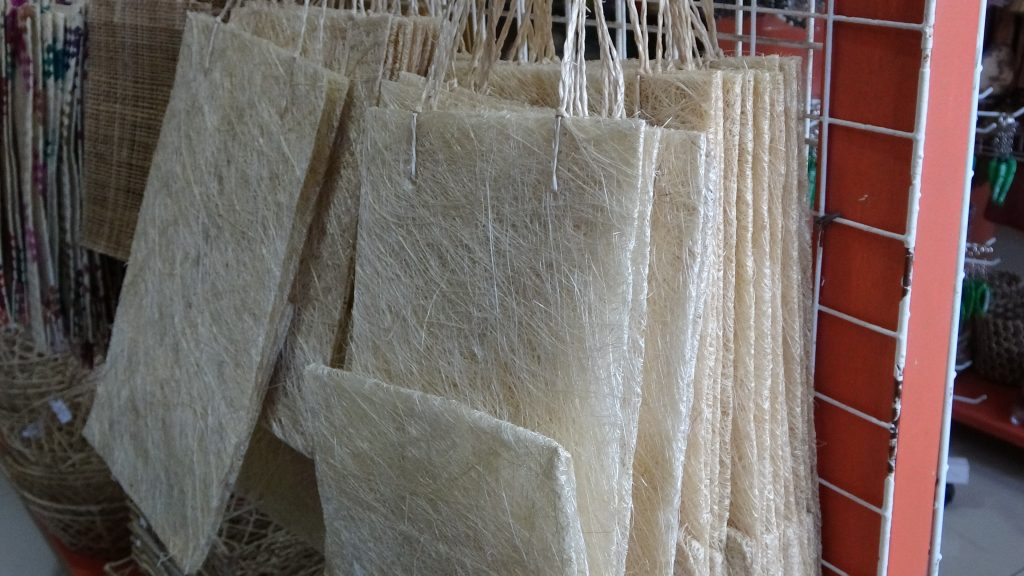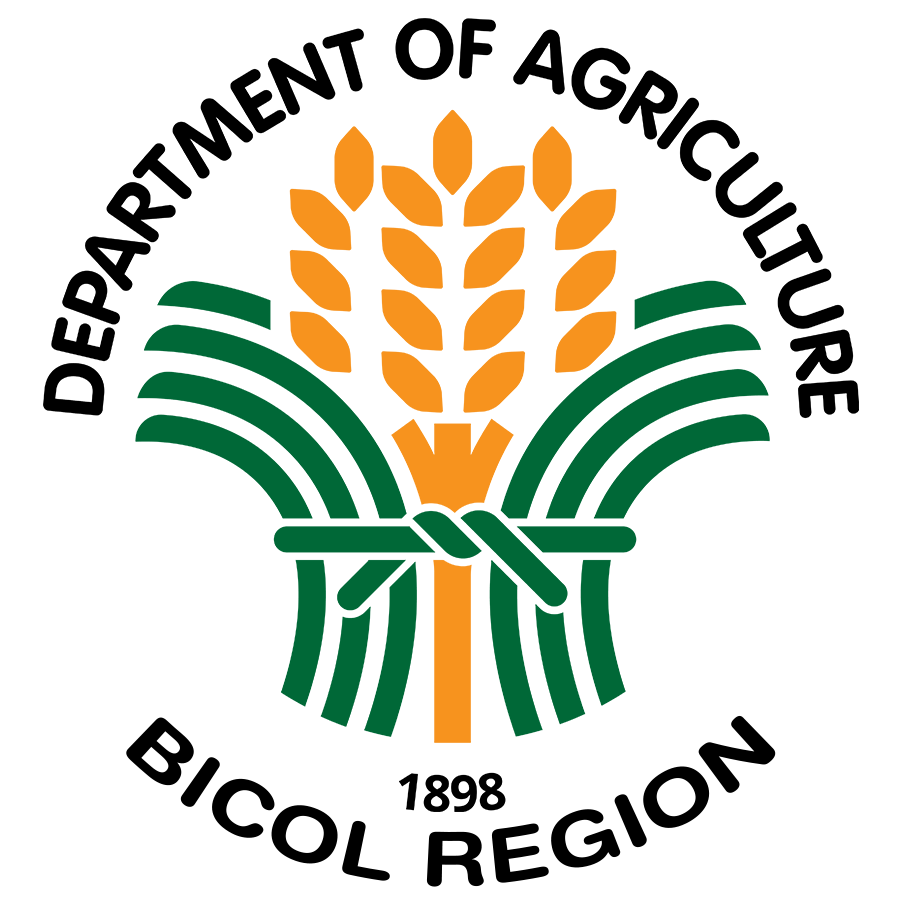Despite the onslaught of strong typhoons that devastated the province in the past and the slack abaca fiber market as a lingering effect of the COVID-19 pandemic, Catanduanes touted as the abaca capital of the Philippines remains as top producer of the world’s strongest natural fiber. The province has 36,853 hectares abaca production area cultivated by 15,000 abacaleros.
A number of abaca fiber processors are making headway in abaca crafts such as handwoven abaca fabrics made into Filipiniana, novelty bags, coin purse, bottle and plant holder, abaca mat, key chain, abaca waste paper, abaca as polymer reinforcement, reinforced bullet proof vest and helmet. These abaca processors buy dried abaca fiber from farmers.
One of the abaca farmers in Catanduanes is Mang Alejo Tayamora. He laments the low buying price of abaca fiber. “Dapat mabigyan din kami ng makinang pang hagot na maaring dalhin sa bukid. He is referring to a portable spindle machine which he could bring up to his farm in the mountainous area of Bgy. Bagumbayan, Bato. He has the best abaca variety known as “Abuab”. He together with his hired abaca stripper can strip 5 up to 10 kilos of dried abaca fiber a day which they sell at P40.00 per kilo to a local trader.
Meanwhile, Elsie Cabrera, one of the licensed processors of the PHilFIDA is also an accredited trainor of TESDA. She buys dried abaca fibers from a number of abacaleros coming from the municipalities of Gigmoto, Baras, San Miguel, Viga and Virac. “ Nitong huling linggo ng Enero 2024 nakabili ako ng 6,500 kilong dried abaca fiber mula sa mga magsasaka dito at sa mga karatig na bayan,” she said. She buys different abaca fiber grades at different prices: S2 at P80 per kilo (dried fiber); I at P65 to P67 per kilo; JK at P40 per kilo; G, H, and M1 grade which has the lowest price. She has a group of women weaver who weave these dried fibers into artful handicrafts such as bags, Filipiniana, plant holder and house decors. “Dito sa Catanduanes maraming trained na weavers pero walang consolidators o bulk buyers ng mga handicraft products. Sana matulungan kami ng Provincial Government na magkakaroon ng consolidator ang aming mga produkto, tiyak na mas uunlad ang industriya ng abaca dito sa Catanduanes” she quipped.
During the COVID-19 pandemic there was a huge demand from other countries for the abaca fibers as it was used as raw material for the PPE and face mask. But the demand for the abaca particularly from European countries stopped abruptly after the pandemic.
Elsie’s sentiments were shared by Antonio A. Jimenez, Jr. General Manager of the Pinoy Lingap Damayan Cooperative (PLDC) based in Virac, Catanduanes. “Sana ay maibalik yun dating presyo na P85 to P95 per kilo ng dried handstripped na abaca fiber, yun JK ito noong nag “boom” talaga ang abaca. Wala na kase ngayon yun at least P15 to P18 na price gap kaya nagreresulta sa huge losses. Halimbawa na lang sa resico, pag pinatuyo ang abaca mas malaki ang nawawala.”
Jimenez also plead with the Central Bank to reconsider using abaca fiber in peso notes. “Matibay naman ang abaca, sana ibalik ng Central Bank. Our farmer members did not stop producing abaca because ito ang kabuhayan ng 70% ng aming more than 10,000 members. Abaca is the major livelihood in our province. What we need now are buyers who will buy our abaca fibers. We are very willing to produce fibers based on the demand of the buyers”. The PLDC was recipient of P10.2M worth Abaca Fiber Processing and Trading Enterprise from DA-Philippine Rural Development Project (PRDP).
Anita Tasara, Chairperson of the Provincial Agricultural and Fishery Council (PAFC) shared that the council implemented food for work projects and intensified Gulayan sa Bakuran program to help improve the nutrition status of the province. “Nananawagan po ako sa ating gobyerno, dahil damang dama ko po ang pangangailangan ng suporta ng abaca. Bilang chairperson din po ako ng PLDC, may fiber trading po kami at wala pong market. Bumili man po kami ng abaca fibers, kung walang pagdadalhan ay malulugi po kami,” she said. “May mga asosasyon kagaya ng Mabato Integrated Farmers ng San Miguel na gumagawa ng mga bags at handicrafts mula sa abaca, subalit kailangan po nila ng puhunan, at hindi kaagad ito naima-market. Unlike yun abaca fiber na pag natuyo, pera na kaagad,” Tasara added.
According to Provincial Agriculturist Ace William Tria, the P79M worth abaca revitalization project provided by the Department of Agriculture and Philippine Fiber Industry Development Authority (PhilFIDA) in 2020, after the super typhoon Rolly hit the island province, has helped the abaca farmers recover and continue producing abaca. “Nakapagprovide ito ng mga planting materials at mga bagong kagamitan sa mga abaca farmers. The PLGU also partnered with the Department of Labor and Employment (DOLE) and helped the out of school youths and rural women engaged in abaca. Ang abaca ay isa sa priority projects ni Governor Joseph Cua and may on-going establishment of abaca nursery and greenhouse kami sa Virac. We are also encouraging LGUs to establish their respective municipal abaca nurseries as mandated under Provincial Ordinance No. 007 – 2019 or the Abaca Sustainable Development para maka avail ng quality planting materials ang mga abaca farmers.”
Tria also added that there is a need to strengthen market linkages through the help of the National Government Agencies. “Isa pa ay kailangan palakasin mismo ang PhilFIDA kase talaga namang kulang sila sa manpower. Kailangan din mabigyan ng pondo ang PhilFIDA lalo dito sa Catanduanes dahil abaca ang major commodity ng probinsiya being the abaca capital of the Philippines,” he added. Tria thanked the Department of Agriculture for the all-out support to the abaca industry of Catanduanes.
According to the Phil. Abaca Industry Roadmap, abaca remains the most important fibercrop in thecountry in terms of hectarage, production and contribution to the nation’s economy, among the 30 fibercrops in the Philippines,.
The Philippines used to dominate the global abaca trade as the country supplied an average of 85.4 percent of the world’s abaca fiber requirements with Ecuador and Costa Rica the remaining 14.4 percent and 0.2 percent, respectively, from 2010-2019. Although the bulk of the country’s abaca fiber production was processed locally, most of these processed products, particularly abaca pulp (78.6%), cordage/rope (4.9%), and fibercraft/fabrics (0.9%), fabrics and yarns (0.7%) raw fiber (14.9%) were exported abroad. About 97.0% of the total abaca production in the country is exported which generated an equivalent of more than Php8 billion revenue in 2019. (The Phil. Abaca Industry Roadmap)
In the Philippines, abaca is produced in 13 abaca producing regions in the country with a combined area of 162,507 hectares by a total of 127,226 abaca farmers as of end of 2022. Among the 13 abaca producing regions of the Philippines, Bicol Region has the biggest abaca production during the last five years (2018-2022) contributing an average of 33.50% to the total abaca production in the country. Davao contributed 19.40% and CARAGA region contributed 13.70% share in the domestic abaca production while the 33.4% is a combine supply from other regions.
But due to the strong typhoons that devastated the Bicol Region in 2016, 2019 and 2020, abaca production in the Bicol region has declined – with a recorded -27.92% cumulative decrease over five year period. Still, Catanduanes ranked first among the top 10 abaca producing provinces in the country contributing 28% to the total production of the country in 2022.
The devastation caused by calamities was not the only problem of the abaca farmers in Catanduanes.
Roberto Lusuego, provincial head of PhilFIDA in Catanduanes said that another problem is the limited funding support from the national coffers despite the RA 11700 declaring Catanduanes as abaca capital of the Philippines. In year 2023 the PhilFIDA Region 5 was allocated with P61M for its program implementation in the six provinces. The PhilFIDA also lacks manpower as there are only four technicians to cover over 15,000 abaca farmers in the province. The function of the agency is limited to regulatory, licensing and fiber inspection. “If all the abaca plantations in the province will be maximized, Catanduanes can achieve 35,000 to 40,000 MT production of abaca annually. But now, the province only produces 18,000 to 22,000 MT abaca annually due to lack of market,” Lusuego added.
Mary Anne R. Molina, OIC Regional Director of the Philippine Fiber Industry Development Authority (PhilFIDA) in region 5 said that PhilFIDA is implementing various programs including Research and Development (R&D) activities aimed at advancing science and technology associated with natural fibers, production support to enhance the propagation and post-harvest processes, extension support, education and training programs to equip farmers with technical knowledge and skills on Good Agricultural Practices and value adding for increased income and productivity.
The agency also implements abaca disease management program; technical assistance on the opening or rehabilitation of fibercrop areas; provision of fiber-based skills training/livelihood opportunities in abaca-farming communities, particularly for women, youth, senior citizens, and Persons with Disabilities (PWDs) in collaboration with the LGUs, NGAs, and NGOs.
The PhilFIDA is also implementing the Abaca TUXY Buying Special Project (ATBSP-SCHEME I) which aims to organize and empower abaca farmers as a cooperative, produce their own abaca fibers as a group and sell their harvest directly to Grading and Baling Establishments and local processors. In Caramoran, Catanduanes, PhilFIDA has a special project called “Abaca Tuxy Buying” benefitting more than 100 beneficiaries of the Caramoran Abaca Farmers Producers Coop (CAPCO). The project amounted to P18M for the building and equipment and P2.7M for capital build up.
Another special project is the HIBLA Farming Mechanization which include the distribution of Modified Abaca Stripping Knives (MASK) and Spindle Stripping Machines and the construction of an Abaca Processing Center, mostly at a strategic location and with a group of eligible abaca farmers with existing harvestable abaca farms. The PhilFIDA also conducts training for the beneficiaries to increase awareness and learn technical know-how on the operation and maintenance of the processing tools and machines.
A new technology for adoption or commercialization is the Modified Abaca Stripping Knife (MASK). This is a device designed by PhilFIDA to enable abaca farmers produce practically all fiber grades in PNS for hand-stripped Abaca thru traditional/manual fiber extraction. Said device will produce quality and standard fiber grades acceptable in local and export markets.
PhilFIDA is also maintaining abaca-field nurseries; genebank in Sorsogon Fiber Experiment Station (SFES) at San Juan, Casiguran, Sorsogon & in vitro collection in tissue culture laboratories in Albay & Sorsogon, Bicol.
Meanwhile, the DA PRDP has been helping the abaca industry through conduct of meetings with PhilFIDA to create partnership for them to provide trainings and PRDP for logistics and facilitate market matching of abaca products.
During the Regional Management Committee (RMC) meeting of all the heads of DA attached agencies of Bicol on January 30, 2024, DA Bicol Regional Executive Director Rodel P. Tornilla pledged his full support for the revitalization of the abaca industry in Catanduanes.
With all these supports from the different stakeholders, the abaca farmers of Catanduanes are optimistic that sustainable market for abaca will be realized and Catanduanes will regain its niche in the global market to help the Philippines maintain its status as the world’s top producer and supplier of quality abaca fibers. (By Lovella P. Guarin, DA RAFIS 5)
